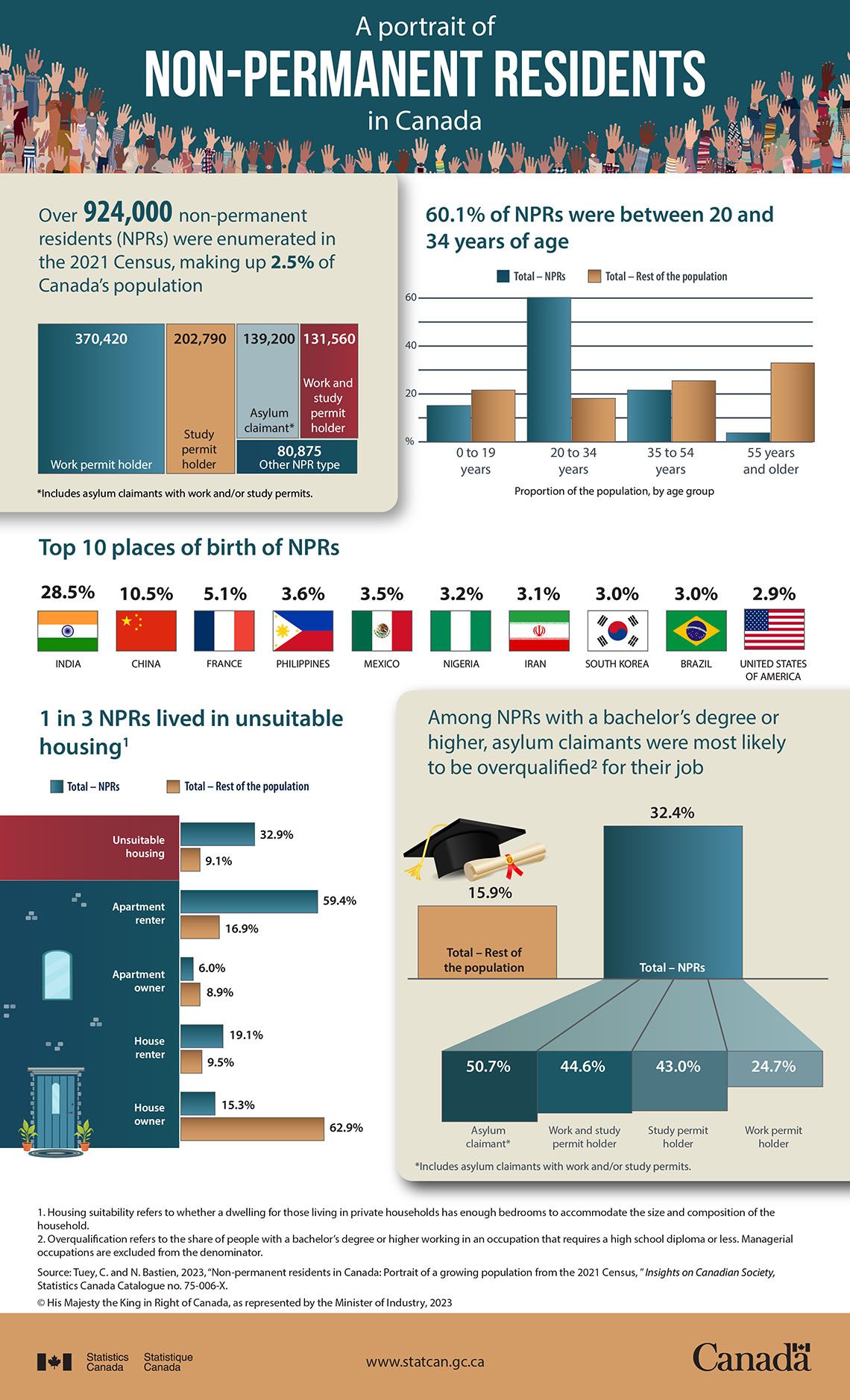The Statistics
According to a recent release by Statistics Canada titled “A Portrait of Non-Permanent Residents in Canada,” NPRs play a crucial role in the country’s population, fulfilling essential labor needs in key sectors, actively participating in the postsecondary education system, and contributing to the Canadian economy as consumers. Despite Canada being one of the most multi-ethnic countries globally, with a diverse population of 38.25 million, the 2021 census revealed that nearly 1 million of them were non-permanent residents, making up an impressive 2.5% of Canada’s population in that year. The statistics could be then broken down into Asylum claimants, work and study permit holders, study permit holders, work permit holders and other NPR types.
Gaining insights into these different segments of NPRs can provide a deeper understanding of immigrant groups’ circumstances and help develop effective marketing strategies tailored to their needs. Notably, Chinese NPRs deserve particular attention, given that Statistics Canada reported that in 2021, 10.5% of NPRs were born in China, making China the second biggest contributor of NPRs in Canada. This percentage represents a substantial amount of potential consumers which will benefit businesses and the overall economy. Surprisingly, marketers often overlook this group despite their significance.

In 2021, 924, 850 NPRs (close to 1mil) made up 2.5% of Canada’s population
|
NPRs with work permit only |
NPRs with study permit only |
NPRs with work and study permit |
Other NPR types |
Asylum Claimants |
|
|
Percentage of NPRS from China |
7.7 |
19.8 |
11.7 |
11.5 |
3.1 |
|
Numbers of Chinese NPRS |
71, 214 |
183, 121 |
108, 208 |
106, 358 |
28, 671 |
Source: Statistics Canada Table 4 Top 10 places of birth, by non-permanent resident type, 2021
NPR PopulationTrends
While the majority of NPRs who arrived in Canada in 2021 were work permit holders, it was noted that NPRs from China were most likely to have only a study permit. This means advertising products with international students in mind will garner positive attention. Furthermore, Statistics Canada also noted that “NPRs are younger than the rest of the Canadian population” (Statistics Canada). NPRs with work permits were predominantly between the ages of 25 to 34 years old. While those with study permits or both study and work permits were most commonly in their early 20s (Statistics Canada).

Considering the perspective of immigrants, they have arrived in a fairly unfamiliar country and must be prepared to make the necessary purchases to begin their new life. They will likely make purchases such as a new phone plan, rent a home or auto insurance, buy a car, set up bank accounts and etc., but may struggle to know which brands to trust. According to the Multicultural Marketing report: Building Confidence–The Newcomer Journey, “Newcomers to Canada are looking to build confidence in their purchase journey. It’s important for marketers to understand the typical newcomer journey to Canada to know the right time to show up for them, and how.”
For this reason, we highly recommend leveraging Chinese social media platforms such as WeChat, Weibo and Xiaohongshu ( a.k.a. Little Red Book ) as Chinese migrants in North America can be viewed as ‘transplanted consumers’. They maintain the same media usage habits and consumer values before they were acculturated—finding comfort in familiar foods and entertainment. Thus, reaching them through their favorite and most visited Chinese websites, mobile apps, and video streaming platforms will be the most effective method of advertising.
Chinese Visitors
Chinese tourists have been known to have a keen interest in exploring international destinations and have a reputation for spending more capital than visitors from any other nation (Destination British Columbia). With the ease in pandemic restrictions, the tourism industry has experienced rebound and people’s desire to travel, particularly among Chinese tourists has been heightened through the summer months of 2023. It is highly likely many of them will visit Canada as it is one of the best options for their vacation and when planning their work holidays. This is especially applicable if they have family or friends who are already living or have settled in Canada. Parents who come to visit their immigrant family can potentially stay up to 6 months at a time for up to 10 years with their temporary visas, and this is very common in Chinese communities all over Canada. Lots of them see Canada as their second home and they would travel between China and Canada as frequent as every year and stay here for a few months every time. This semi-permanent residents segment has strong spending power and plays a very important role in the Chinese consumers market in Canada.
The trend is supported by the 2021 Census data which stated that 31.5% of all children in Canada have at least one parent born abroad. These strong familial ties drive Chinese visitors to choose Canada as their preferred destination.

Rise of the Immigration Population in Canada
Remember that the 2021 Census was conducted during the Covid time when travel was still restricted. Given that the Pandemic is now over, the number of non-permanent residents will continue to rise as anticipated, by 2036 immigrants will represent up to 30% of the Canadian population (IRCC). Looking at the Immigration, Refugees and Citizenship Canada (IRCC) statistics, in addition to the high number of applications for temporary residents, we can also see a high number of applications received for permanent residency. Showing that there is a high probability and desire for Chinese NPRs to become permanent residents in Canada. However, this may not be necessarily translated into numbers of new Canadian citizens due to the slow processing of Canada’s Immigration system. The good news is, the government of Canada is working to counter this issue with the implementation of the Fall Economic Statement, which committed an additional $50 million from 2022-23 in assisting a faster IRCC processing.
Eastward Media specialize in helping brands target Chinese consumers in Canada and the United States, we help marketers define and understand their target audience to build Chinese digital marketing plans that work to achieve goals. Contact us today to talk about your Chinese marketing plan.

